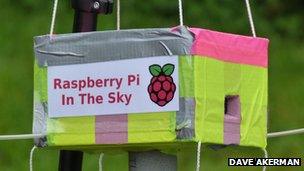Sky high success for Raspberry Pi computer
- Published

The Pi snapped pictures almost 40km above the Earth
A Raspberry Pi computer has boldly gone where no other Pi has gone before.
High-altitude ballooning enthusiast Dave Akerman tethered one, complete with a webcam to photograph its progress, to a helium balloon.
The bare-bones computer managed to reach an altitude of almost 25 miles (40km) before the balloon popped and it returned to Earth.
The Pi sent live images throughout the flight and was safely retrieved by tracking its onboard radio transmitter.
Sky high
Mr Akerman decided to use a Raspberry Pi to control the payload on his near-space craft because its USB port made it easy to connect up a cheap webcam.
Prior to using the Pi, Mr Akerman had relied on payloads built around the Arduino microcontroller to power the sensor package lifted by the balloon.
These too can control a camera, however, said Mr Akerman they were much more expensive and harder to use than a familiar webcam.
"The Pi is not the obvious choice for this," he told the BBC. "I chose it because it was on my desk and I thought it would be a neat thing to use."
Using the Pi had introduced problems because it was relatively heavy, complicated and drew quite a lot of power, he said.

The Pi payload was protected against the harsh conditions in the upper atmosphere
<link> <caption>On his blog, Mr Akerman detailed the process of solving</caption> <url href="http://www.daveakerman.com/?p=592" platform="highweb"/> </link> these problems, which produced a flight computer that could take live images of its ascent, select the best shot, and then feed it back to ground control.
Also onboard was an altimeter and a radio beacon to help retrieve the high-altitude Pi.
Strong winds and rain delayed the launch, but when the balloon got off the ground it reached an altitude of 39,994m.
"Quite amazing for a medium-sized balloon with about 1kg (2lb) of payloads underneath it," wrote Mr Akerman.
The dramatic live pictures it sent during its journey are believed to the <link> <caption>highest ever photographs transmitted from an amateur device anywhere in the world</caption> <url href="http://www.raspberrypi.org/archives/1620" platform="highweb"/> </link> .
The onboard radio beacon ensured the craft could be tracked as it made its descent and helped Mr Akerman retrieve the pioneering machine when it came down only a few miles away from the launch pad.
He is now planning a second flight for his Pi craft, which survived its maiden flight completely unscathed. The next ascent will add a video camera to the payload to capture footage of its journey.
- Published9 July 2012
- Published16 July 2012
- Published27 April 2012